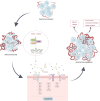Advances in targeting tumor microenvironment for immunotherapy
- PMID: 39421736
- PMCID: PMC11484021
- DOI: 10.3389/fimmu.2024.1472772
Advances in targeting tumor microenvironment for immunotherapy
Abstract
The tumor microenvironment (TME) provides essential conditions for the occurrence, invasion, and spread of cancer cells. Initial research has uncovered immunosuppressive properties of the TME, which include low oxygen levels (hypoxia), acidic conditions (low pH), increased interstitial pressure, heightened permeability of tumor vasculature, and an inflammatory microenvironment. The presence of various immunosuppressive components leads to immune evasion and affects immunotherapy efficacy. This indicates the potential value of targeting the TME in cancer immunotherapy. Therefore, TME remodeling has become an effective method for enhancing host immune responses against tumors. In this study, we elaborate on the characteristics and composition of the TME and how it weakens immune surveillance and summarize targeted therapeutic strategies for regulating the TME.
Keywords: cancer; immunosuppression; immunotherapy; targeted; tumor microenvironment.
Copyright © 2024 Wang, Zhang, Zhang, Wu, Zhang and Chen.
Conflict of interest statement
The authors declare that the research was conducted in the absence of any commercial or financial relationships that could be construed as a potential conflict of interest. The author(s) declared that they were an editorial board member of Frontiers, at the time of submission. This had no impact on the peer review process and the final decision.
Figures




Similar articles
-
Hijacked Immune Cells in the Tumor Microenvironment: Molecular Mechanisms of Immunosuppression and Cues to Improve T Cell-Based Immunotherapy of Solid Tumors.Int J Mol Sci. 2021 May 27;22(11):5736. doi: 10.3390/ijms22115736. Int J Mol Sci. 2021. PMID: 34072260 Free PMC article. Review.
-
Emerging role of metabolic reprogramming in tumor immune evasion and immunotherapy.Sci China Life Sci. 2021 Apr;64(4):534-547. doi: 10.1007/s11427-019-1735-4. Epub 2020 Aug 17. Sci China Life Sci. 2021. PMID: 32815067 Review.
-
Nanoengineered Immune Niches for Reprogramming the Immunosuppressive Tumor Microenvironment and Enhancing Cancer Immunotherapy.Adv Mater. 2019 Aug;31(34):e1803322. doi: 10.1002/adma.201803322. Epub 2019 Feb 18. Adv Mater. 2019. PMID: 30773696 Review.
-
Tumor microenvironment: recent advances in understanding and its role in modulating cancer therapies.Med Oncol. 2025 Mar 18;42(4):117. doi: 10.1007/s12032-025-02641-4. Med Oncol. 2025. PMID: 40102282 Review.
-
Emerging Role of Extracellular pH in Tumor Microenvironment as a Therapeutic Target for Cancer Immunotherapy.Cells. 2024 Nov 20;13(22):1924. doi: 10.3390/cells13221924. Cells. 2024. PMID: 39594672 Free PMC article. Review.
Cited by
-
Retrospective study on the prognostic prediction of inflammatory markers and the C-reactive protein/albumin ratio in first-line immunotherapy for advanced HER2 negative gastric cancer patients.Transl Cancer Res. 2025 Mar 30;14(3):2043-2053. doi: 10.21037/tcr-2025-192. Epub 2025 Mar 17. Transl Cancer Res. 2025. PMID: 40224991 Free PMC article.
-
Spatial transcriptomics and scRNA-seq: decoding tumor complexity and constructing prognostic models in colorectal cancer.Hum Genomics. 2025 Aug 13;19(1):92. doi: 10.1186/s40246-025-00805-x. Hum Genomics. 2025. PMID: 40804688 Free PMC article.
-
Cancer stem cells in personalized therapy: mechanisms, microenvironment crosstalk, and therapeutic vulnerabilities.Front Cell Dev Biol. 2025 Jul 30;13:1619597. doi: 10.3389/fcell.2025.1619597. eCollection 2025. Front Cell Dev Biol. 2025. PMID: 40809695 Free PMC article. Review.
-
Signature Gene Mutations in Colorectal Cancer: Potential Neoantigens for Cancer Vaccines.Int J Mol Sci. 2025 May 9;26(10):4559. doi: 10.3390/ijms26104559. Int J Mol Sci. 2025. PMID: 40429703 Free PMC article. Review.
-
The role of RETN in stomach adenocarcinoma (STAD): insights from pan-cancer analysis of RNA-seq data based on the TCGA database.Discov Oncol. 2025 May 25;16(1):921. doi: 10.1007/s12672-025-02755-1. Discov Oncol. 2025. PMID: 40413699 Free PMC article.
References
Publication types
MeSH terms
LinkOut - more resources
Full Text Sources
Medical

